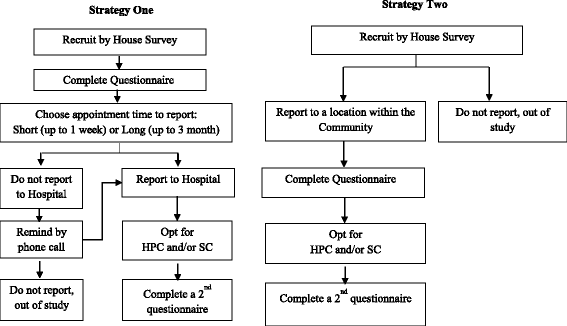A tailored within-community specimen collection strategy increased uptake of cervical cancer screening in a cross-sectional study in Ghana
- PMID: 28764756
- PMCID: PMC5540566
- DOI: 10.1186/s12889-017-4631-y
A tailored within-community specimen collection strategy increased uptake of cervical cancer screening in a cross-sectional study in Ghana
Erratum in
-
Erratum to: BMC Public Health, Vol. 18.BMC Public Health. 2017 Sep 22;17(1):736. doi: 10.1186/s12889-017-4709-6. BMC Public Health. 2017. PMID: 28938882 Free PMC article. No abstract available.
Abstract
Background: The implementation of cervical cancer screening strategies has reported different rates of success in different countries due to population specific factors that limit women's participation. We report observations and the development of a community-based specimen collection strategy which resulted from interactions with women in the study communities, following an initial low response to a hospital based cervical cancer screening strategy.
Method: Women were recruited by a house survey and invited to report at a hospital either within a week or after a week for self and health-personnel specimen collections. However, due to the very low response and subsequent interactions with the women of the communities, another strategy was developed that required recruited women report at a central location within their respective communities for specimen collections at times that did not interfere with their daily routines.
Results: For specimen collection, of the 156 participants who opted to report after a week at the hospital, 60 (38.5%) reported. Of the 118 participants who opted to report within 1 week at the hospital, 55 (46.6%) reported. Of the 103 participants were invited to report at a specified location within the community, 98 (95.1%) reported. An overall response rate of 60.4% was attained. Almost 89.7% (226 of 253) of the women performed both self and health personnel sample collection.
Conclusion: The community-based strategy with self-specimen collection and HPV testing holds great potential for increasing women's participation in cervical cancer screening in Ghana as compared to the hospital based strategy.
Keywords: Cervical cancer; Cervical screening; Ghana; HPV testing; Pap smear; Self-sampling.
Conflict of interest statement
Ethics approval and consent to participate
This study was approved by the Ghana Health Service Ethical Review Committee (with the ID Number GHS-ERC: 06/11/10), and conducted in accordance to the ethical standards as declared in the Declaration of Helsinki and the Belmont Report. Specifically, the study was only commenced following the approval of ethics committee and the provision, to each prospective participant (and the parents of participants who were younger than 16 years), of the full information and other relevant explanations regarding the study (such as its objectives, benefits to science and the participants, the role of the participants in the study and their contributions as well as the risk involved in taking part in the study). In addition, participants’ autonomy regarding their participation in the study was fully explained to and respected, and those who volunteered to participate, confirmed same by providing written informed consent; for participants younger than 16 years, verbal parental consent were additionally obtained. Assurances were given and efforts were made to protect the privacy and confidentiality of the participants enrolled and their collected data. As such personal/demographic data as well as data that will be useful for identifying the participants were coded and kept separately with linker codes.
Consent for publication
Not applicable.
Competing interests
The authors declare that they have no competing of interests.
Publisher’s Note
Springer Nature remains neutral with regard to jurisdictional claims in published maps and institutional affiliations.
Figures
References
-
- GLOBOCAN, IARC. (2012) GLOBOCAN 2012: estimated cancer incidence, mortality and prevalence worldwide in 2012; Fact Sheets.
MeSH terms
LinkOut - more resources
Full Text Sources
Other Literature Sources
Medical
Research Materials



